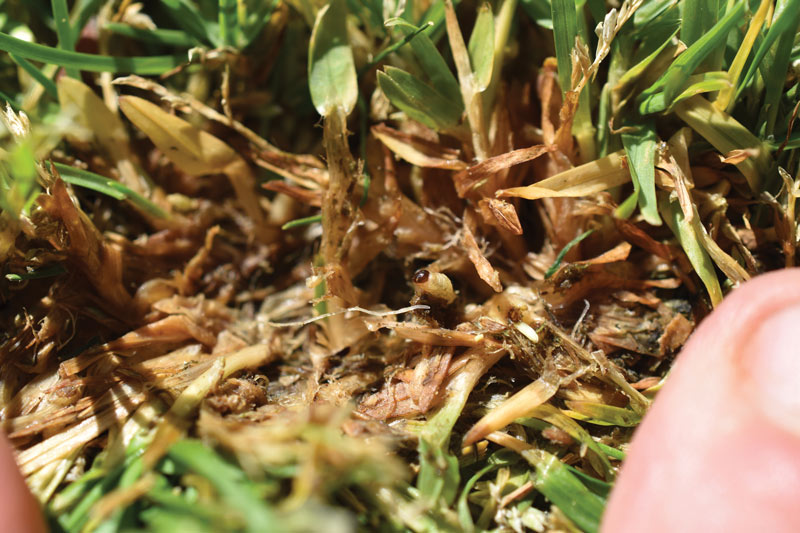
Figure 1. Annual bluegrass weevil larva emerging annual bluegrass in research plots on May 23, 2018. Photo by Katherine Diehl
Editor’s note: This research was funded in part by the GCSAA Foundation.
Annual bluegrass (Poa annua L.) is more sensitive to biotic and abiotic stresses than other cultivated cool-season turfgrasses and is thus often considered a weed (1). Annual bluegrass is more prone to injury from the annual bluegrass weevil (ABW; Listronotus maculicollis Kirby), and the ABW’s host-preference for annual bluegrass is well documented (3, 4). However, research has not yet evaluated ABW for annual bluegrass control in mixed species turfgrass stands.
Herbicidal options for annual bluegrass control are limited in cool-season turfgrass. Although creeping bentgrass (Agrostis stolonifera L.) safety is often a limiting factor, even selective herbicides are not always advisable, as rapid annual bluegrass control can result in unacceptable turf loss where initial cover is high (5, 8). The plant growth regulators (PGRs) paclobutrazol and flurprimidol offer gradual annual bluegrass control when applied sequentially in creeping bentgrass greens and fairways (2, 6, 10, 11, 12).
This research evaluated the multiyear effects of three ABW insecticide programs on annual bluegrass control and turfgrass quality in fairways, alone and in combination with various paclobutrazol programs and creeping bentgrass overseeding. We hypothesized that threshold-based insecticide applications for ABW control could reduce annual bluegrass cover in creeping bentgrass fairways over time, and that monthly paclobutrazol applications would further increase control.
Materials and methods
Two field experiments were conducted and replicated in time. Experiment 1 was a two-year field experiment conducted from 2017 to 2019 at two locations with histories of ABW. This study investigated the effects of three insecticide programs, creeping bentgrass overseeding, and monthly paclobutrazol applications (Trimmit 2SC, Syngenta) at 0.25 pounds active ingredient per acre (16 fluid ounces product per acre; 280 grams active ingredient per hectare) from annual bluegrass seedhead shatter through October for annual bluegrass control.
In 2017 and 2018, research was conducted on a simulated golf fairway at Rutgers Hort Farm No. 2 (North Brunswick, N.J.), where estimated annual bluegrass cover was 85% when the experiment began. In 2018 and 2019, a replicate experiment was conducted on a golf fairway at Forest Hill Field Club (Forest Hill, Bloomfield, N.J.), where cover was visually estimated to be 15% creeping bentgrass, 10% perennial ryegrass (Lolium perenne L.) and 75% annual bluegrass when the experiment began.
Overseeding treatment consisted of 007 creeping bentgrass seeded at 1 pound pure live seed per 1,000 square feet (50 kilograms per hectare) one week after the threshold insecticide program was initiated (see below for insecticide program details). Treatments were replicated four times and arranged as a 2 × 3 × 2 factorial in a split-split plot randomized complete block design. Overseeding served as the whole-plot factor, insecticide program as the sub-plot, and paclobutrazol as the sub-sub-plot, 3 feet by 6 feet (0.9 meters by 1.8 meters).

Table 1. Conversion table of paclobutrazol rates evaluated in the second experiment. PGR programs consisted of paclobutrazol rates applied using the Trimmit 2SC formulation every 28 days from annual bluegrass seedhead shatter in spring until October.
In 2018 and 2019, Experiment 2 was conducted on the same fairway at Hort Farm 2. This study investigated the same three insecticide programs in combination with lower rates of paclobutrazol: high (12 fluid ounces product per acre; 210 grams active ingredient per hectare), medium (6 fluid ounces per acre; 105 grams active ingredient per hectare), low (4 fluid ounces per acre; 70 grams active ingredient per hectare); and a non-treated control (Table 1, above). The objective of this research was to further examine the effects of the ABW with lower rates of paclobutrazol commonly used by superintendents. Treatments were replicated four times and arranged as a 3 × 4 factorial in a split-plot randomized complete block design. Sub-plots were 3 feet by 6 feet.
ABW insecticide programs
Three ABW insecticide programs (preventive, threshold and no insecticide) were evaluated for annual bluegrass control (Table 2). Insecticide applications were timed using larvae sampling, growing degree-day accumulation starting March 1 (base temperature 50 F; 10 C) and phenological indicator plants.
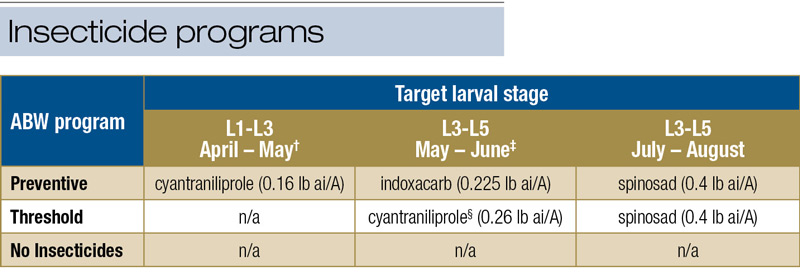 †200 GDD50°F, near late bloom of flowering dogwood (Cornus florida L.)
†200 GDD50°F, near late bloom of flowering dogwood (Cornus florida L.)
‡350 GDD50°F, near full bloom of hybrid Catawba rhododendron (Rhododendron catawbiense M.)
§Applied only once damage threshold is met
Table 2. Annual bluegrass weevil insecticide programs and treatments. Applications were timed using local growing degree day accumulations, on-site scouting and phenological indicators to target specific larval stages. Application months from 2017 to 2019 experiments are listed in the text.
The preventive program was designed to prevent annual bluegrass injury throughout the season. It consisted of the systemic insecticide cyantraniliprole (Ference, Syngenta) applied at approximately 200 GDD50 (80 GDD10) near the late bloom of flowering dogwood (Cornus florida L.) to control early instar larvae of the ABW spring generation, followed by indoxacarb (Provaunt, Syngenta) applied at approximately 350 GDD50 (160 GDD10) near full bloom of hybrid Catawba rhododendron (Rhododendron catawbiense Michx.) to control any surviving spring generation larvae, and spinosad (Conserve, Dow AgroSciences) to control larvae of the first summer generation.
The threshold program withheld insecticides for ABW control until turfgrass quality in non-treated plots met the damage threshold of <6.0 on a 1-to-9 NTEP scale ranking color, density, texture and uniformity (9). If and when the damage threshold was met, cyantraniliprole was applied at 0.26 pounds active ingredient per acre (291 grams active ingredient per hectare) to control spring generation ABW larvae and prevent further plant injury. ABW control continued for the rest of the season using spinosad. No insecticides were applied for ABW control in the third program as a scientific control. Imidacloprid (Merit, Bayer) was applied to all plots in late June for white grub control.
Data and analysis
To objectively determine turfgrass species composition, two 36-inch-by-36-inch (91-centimeter-by-91-centimeter) square grids fitted with 100 evenly spaced intersects were placed over each plot to determine the species present at each intersect each June and October. Annual bluegrass cover was visually evaluated on a scale of 0% (no cover) to 100% (complete cover) monthly during the growing season each year. Turfgrass quality was visually evaluated on a 1-to-9 scale, where 6 was considered acceptable. To evaluate ABW insecticide program efficacy, larval densities were evaluated by salt extraction in early June before new adults started to emerge.
All data were subjected to ANOVA using the GLIMMIX procedure in SAS (v9.4, SAS Institute) with replication as a random effect. The first experiment was analyzed as a split-split-plot design and the second as a 2 × 4 factorial split plot randomized complete block design. Fisher’s Protected LSD test was used to separate means where appropriate (p=0.05). Locations were analyzed separately, as treatment by location interactions occurred on multiple dates and site characteristics were variable.
Annual bluegrass cover
Experiment 1: Overseeding, ABW and paclobutrazol
Overseeding had no effect on annual bluegrass cover or turfgrass quality at either location. Regardless of insecticide program, two years of paclobutrazol applied monthly at 0.25 pounds active ingredient per acre provided consistent annual bluegrass control. At Hort Farm 2, paclobutrazol treatment resulted in 0% annual bluegrass cover after two seasons of applications in April 2019 regardless of ABW program (Figure 2, below). At Forest Hill, paclobutrazol was less effective, with cover reduced to 60%, compared to 80% in the non-treated. We attributed paclobutrazol’s efficacy at Hort Farm 2 to the fairway’s blended canopy, where annual bluegrass was well mixed throughout the stand of bentgrass. Paclobutrazol was less effective on the ryegrass fairway at Forest Hill, where turfgrass species grew in distinctive patches.
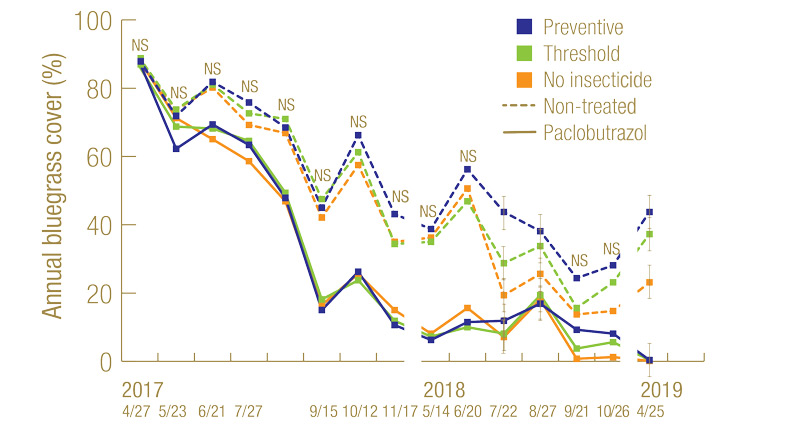
Figure 2. Percent annual bluegrass cover as effected by paclobutrazol and ABW insecticide program on a simulated creeping bentgrass fairway at Hort Farm 2 (North Brunswick, N.J.). Error bars indicate Fisher’s Protected LSD (p=0.05) values to separate means.
Without paclobutrazol, ABW insecticide program affected annual bluegrass cover at Hort Farm 2 in July 2018, August 2018 and on the final rating date in April 2019. On each date, not applying insecticides reduced annual bluegrass (19% cover in July, 26% in August and 23% by April 2019) compared to the preventive program (44% cover in July, 28% in August and 44% by April 2019). The threshold program only reduced annual bluegrass cover (29%) compared to the preventive program in July 2018, as treatments had similar cover from August 2018 (34% and 28%, respectively) onward.
Experiment 2: ABW and paclobutrazol
At the conclusion of both 2018 and 2019 experiments, annual bluegrass cover was highest in the preventive insecticide program not treated with paclobutrazol, and all rates of paclobutrazol (regardless of insecticide program) reduced cover relative to that treatment (Figure 3, below).
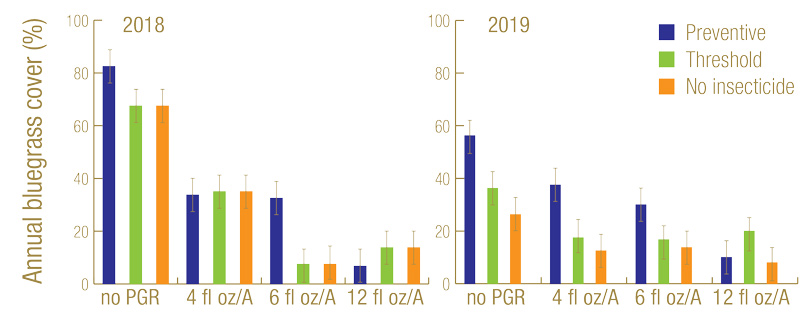
Figure 3. The effect of annual bluegrass weevil insecticide program and paclobutrazol rate on annual bluegrass cover on a simulated creeping bentgrass fairway at the conclusion of replicate one-year experiments on Nov. 30, 2018, and Oct. 22, 2019. Error bars indicate Fisher’s Protected LSD (p=0.05) values to separate means.
Annual bluegrass cover was not affected by insecticide program at the highest paclobutrazol rate, corroborating the results of Experiment 1. At the medium paclobutrazol rate, the threshold and no-insecticide programs reduced annual bluegrass cover compared to the preventive program in both years. A similar response was observed for the low paclobutrazol rate in 2019 but not 2018. Threshold and no-insecticide programs without paclobutrazol had similar cover to preventive programs receiving low and medium rates of paclobutrazol in October 2019. At the conclusion of the 2018 experiment in November, annual bluegrass cover was lowest in the threshold and no-insecticide treatments for the medium rate of paclobutrazol, but the low and high rates of paclobutrazol were not affected by insecticide program. In 2019, annual bluegrass cover reduced with low and medium paclobutrazol rates was further reduced by threshold and no-insecticide treatments, compared to the preventive ABW programs (Figure 4, below).
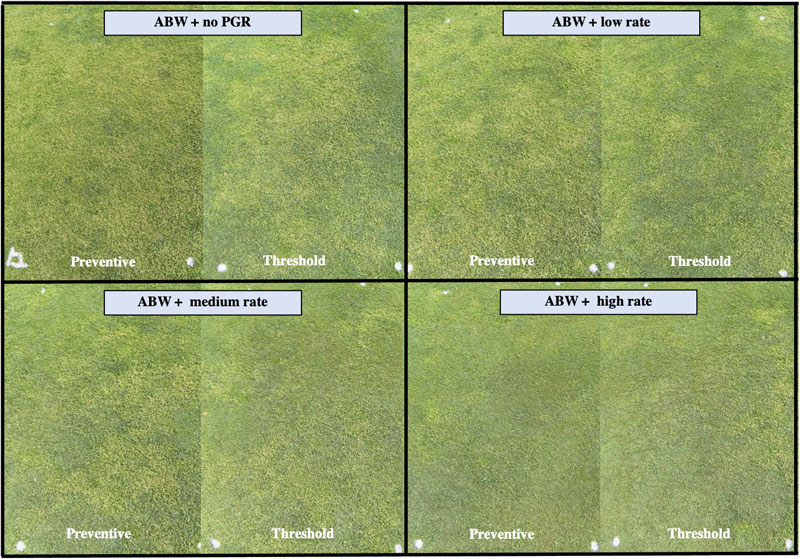
Figure 4. Annual bluegrass cover at Hort Farm 2 in plots treated with preventive (left) and threshold (right) insecticide programs on April 12, 2019, one year after the experiment began.
Turfgrass quality
In the first experiment, turfgrass quality was only affected by insecticide programs in June 2017, and in May, June and July 2018 (Figure 5, below). The preventive treatment provided greater quality in June when first-generation ABW larvae were active in both years. On June 22, 2017, 10 days after the threshold insecticide was applied, turfgrass quality was acceptable (6.0 and 6.7) in threshold and preventive treatments but unacceptable (5.3) in no-insecticide treatments.
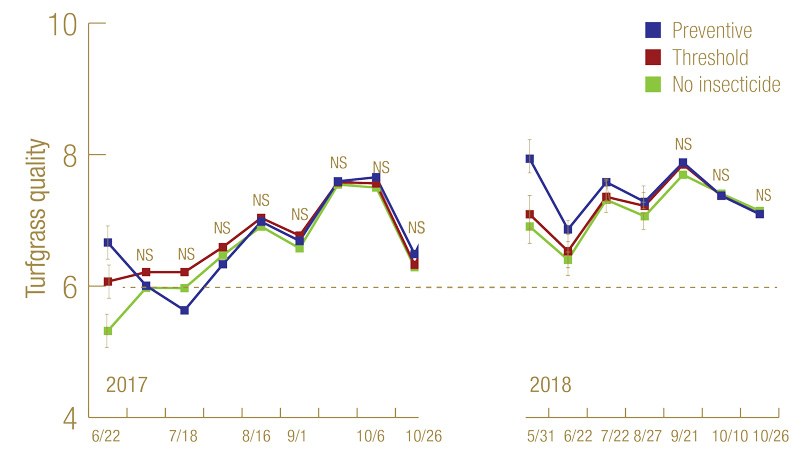
Figure 5. Turfgrass quality as affected by insecticide program across 2017 and 2018 in Experiment 1 at Hort Farm 2. Threshold programs were treated with ABW insecticides June 12, 2017, and June 4, 2018. Error bars indicate Fisher’s Protected LSD (p=0.05) values to separate means.
For both experiments, threshold-based insecticide applications without paclobutrazol resulted in dramatic but mostly temporary reductions in annual bluegrass cover. Although ABW damage was more severe in Experiment 2, we noticed that annual bluegrass was still quick to recover once insecticides were applied to control ABW larvae (Figure 6, below). Annual bluegrass recovery was attributed primarily to annual bluegrass regrowth from surviving plants rather than seed.
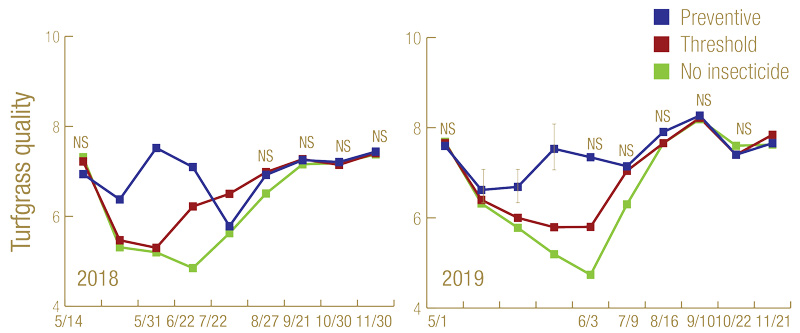
Figure 6. Turfgrass quality aggregated across paclobutrazol programs in 2018 and 2019 for Experiment 2. Damage thresholds were met, and insecticides were applied to threshold plots May 30, 2018 (replicates 1 and 2), and May 24 or June 4 (replicates 3 and 4), 2019. Error bars indicate Fisher’s Protected LSD (p=0.05) values to separate means.
Implications for golf course superintendents
ABW can selectively reduce annual bluegrass cover in creeping bentgrass, but only when allowed to substantially damage annual bluegrass. In these experiments, overall turfgrass quality was only temporarily reduced by ABW damage to a level that would be considered unacceptable to some golfers. This is likely because a high percentage of the turfgrass stand (60%-80%) consisted of annual bluegrass. Creeping bentgrass injury from ABW was never observed in the threshold program. For threshold-based ABW insecticide programs to control annual bluegrass effectively without a PGR program, we suspect that initial annual bluegrass cover must be low to allow ABW to inflict substantial annual bluegrass damage without compromising overall turfgrass quality. If only minor damage is allowed to occur before an insecticide is sprayed, these results suggest lasting annual bluegrass control will be negligible.
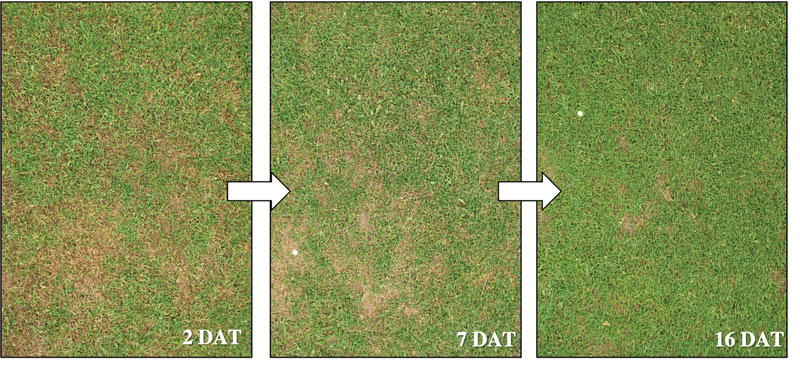
Figure 7. Threshold plot recovery from ABW damage in 2018 after cyantraniliprole (0.26 pounds active ingredient per acre) was applied May 30, 2018, to control ABW larvae in Experiment 2.
The threshold-based insecticide strategy was most practical and effective when combined with a PGR program. In this research we used paclobutrazol, but flurprimidol would likely provide a similar result. Annual bluegrass suppression may not be consistent or substantial if the threshold-based ABW program is used without a PGR program, as annual bluegrass can recover rapidly from damage in late spring. The best strategy would initiate monthly applications of paclobutrazol after seedhead shatter in spring, allow ABW to cause damage until it can no longer be tolerated (by the superintendent or others), and then apply a larvicide at the maximum label rate for ABW control. Programs that used these two strategies together provided more annual bluegrass suppression than either strategy alone and provided a high-quality playing surface for all but one to two weeks of the growing season.
Paclobutrazol rates used in this research ranged from monthly applications at 0.06 to 0.25 pounds active ingredient per acre (67 to 280 grams active ingredient per hectare). Our research supports previous findings that demonstrate paclobutrazol is extremely effective in suppressing annual bluegrass if applied monthly throughout the growing season at high rates. In fact, two years of monthly (April to October) paclobutrazol applications at 0.25 pounds active ingredient per acre completely eliminated annual bluegrass at one site. But although higher paclobutrazol rates (0.19 to 0.25 pounds active ingredient per acre; 213 to 280 grams active ingredient per hectare) provided excellent annual bluegrass suppression on their own, these rates are higher than those used by most superintendents. The medium paclobutrazol rate (0.09 pounds active ingredient per acre; 101 grams active ingredient per hectare) is more typical and provided moderate annual bluegrass suppression on its own. This suppression was further enhanced when combined with the damage-threshold-based ABW insecticide program.
Acknowledgments
This article is based on the following research papers:
Diehl, K.H., M.T. Elmore, A.M. Koppenhöfer, J.A. Murphy and O.S. Kostromytska. 2022. Annual bluegrass weevil and paclobutrazol for annual bluegrass control in cool-season turfgrass. Weed Technology doi:10.1017/wet.2021.106.
Diehl, K.H., M.T. Elmore, A.M. Koppenhöfer, J.A. Murphy and O.S. Kostromytska. 2021. Annual bluegrass weevil, paclobutrazol, and overseeding for annual bluegrass control in cool-season turfgrass. Crop Science 61:1458-1467 doi:10.1002/csc2.20430.
Funding
This research was funded by the GCSAA Foundation, GCSANJ and New Jersey Turfgrass Foundation.
The research says ...
- Annual bluegrass weevil can selectively reduce annual bluegrass cover in creeping bentgrass, but only when allowed to substantially damage annual bluegrass.
- For threshold-based ABW insecticide programs to control annual bluegrass effectively without a plant growth regulator program, we suspect that initial annual bluegrass cover must be low to allow ABW to inflict substantial annual bluegrass damage without compromising overall turfgrass quality.
- The best strategy would initiate monthly applications of paclobutrazol after seedhead shatter in spring, allow ABW to cause damage until it can no longer be tolerated (by the superintendent or others), and then a larvicide at the maximum label rate for ABW control.
Literature cited
- Beard, J., J.M. Vargas, P.E. Rieke and A.J. Turgeon. 1978. Annual bluegrass (Poa annua L.) description, adaptation, culture, and control. Michigan State University Agricultural Experiment Station Research Report 352:3-26.
- Jeffries, M.D., F.H. Yelverton and T.W. Gannon. 2013. Annual bluegrass (Poa annua) control in creeping bentgrass putting greens with amicarbazone and paclobutrazol. Weed Technology 27(3):520-526 (https://doi.org/10.1614/WT-D-12-00144.1).
- Kostromytska, O.S., and A.M. Koppenhöfer. 2016. Responses of Poa annua and three bentgrass species (Agrostis spp.) to adult and larval feeding of annual bluegrass weevil, Listronotus maculicollis (Coleoptera: Curculionidae). Bulletin of Entomological Research 29:72-739 (https://doi.org/10.1017/S0007485316000468).
- Kostromytska, O.S., and A.M. Koppenhöfer. 2014. Ovipositional preferences and larval survival of annual bluegrass weevil, Listronotus maculicollis, on Poa annua and selected bentgrasses (Agrostis spp.). Entomologia Experimentalis et Applicata 152:108-119 (https://doi.org/10.1111/eea.12204).
- McCullough, P.E., and S.E. Hart. 2006. Temperature influences creeping bentgrass (Agrostis stolonifera) and annual bluegrass (Poa annua) response to bispyribac-sodium. Weed Technology 20:728-732 (https://doi.org/10.1614/WT-05-010R2.1).
- McCullough, P.E., S.E. Hart and D.W. Lycan. 2005. Plant growth regulator regimens reduce Poa annua populations in creeping bentgrass. Applied Turfgrass Science 2(1):1-6 (https://doi.org/10.1094/ATS-2005-0304-01-RS).
- McCullough, P.E., S.E. Hart, D. Weisenberger and Z.J. Reicher. 2010. Amicarbazone efficacy on annual bluegrass and safety on cool-season turfgrasses. Weed Technology 24(4):461-470 (https://doi.org/10.1614/WT-D-10-00036.1).
- Meyer, J.W., and B.E. Branham. 2006. Response of four turfgrass species to ethofumesate. Weed Technology 20(1):123-129 (https://doi.org/10.1614/WT-04-187R3.1).
- Morris, K.N., and R.C. Shearman. 2008. “NTEP Turfgrass Evaluation Guidelines.” In NTEP turfgrass evaluation workshop, 1-5, Beltsville, Md. Accessed January 2021. http://www.ntep.org/cooperator.html.
- Patton, A.J., R.C. Braun, G.P. Schortgen, et al. 2019. Long-term efficacy of annual bluegrass control strategies on golf course putting greens. Crop, Forage & Turfgrass Management 5(1):1-10 (https://doi.org/10.2134/cftm2018.09.0068).
- Reicher, Z., and M. Sousek. 2017. Herbicide programs for annual bluegrass (Poa annua L.) control in Nebraska. Crop, Forage & Turfgrass Management 3(1):1-7 (https://doi.org/10.2134/cftm2015.0221).
- Woosley, P.B., D.W. Williams and A.J. Powell. 2003. Postemergence control of annual bluegrass (Poa annua spp. reptans) in creeping bentgrass (Agrostis stolonifera) turf. Weed Technology 17:770-776.
Katherine Diehl is a graduate assistant, Matthew Elmore is an assistant Extension specialist in the Department of Plant Biology, Albrecht M. Koppenhöfer is an Extension specialist in the Department of Entomology, and James Murphy is an Extension specialist in the Department of Plant Biology, all at Rutgers University, New Brunswick, N.J. Olga S. Kostromytska is an Extension assistant professor in the Stockbridge School of Agriculture, University of Massachusetts, Amherst, Mass.